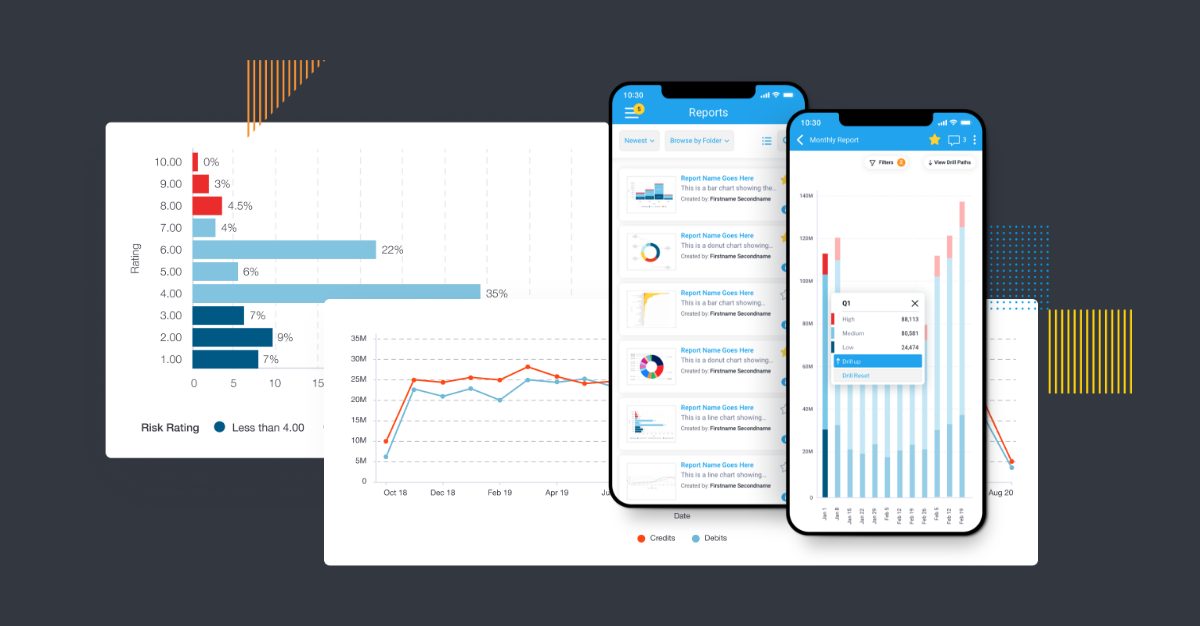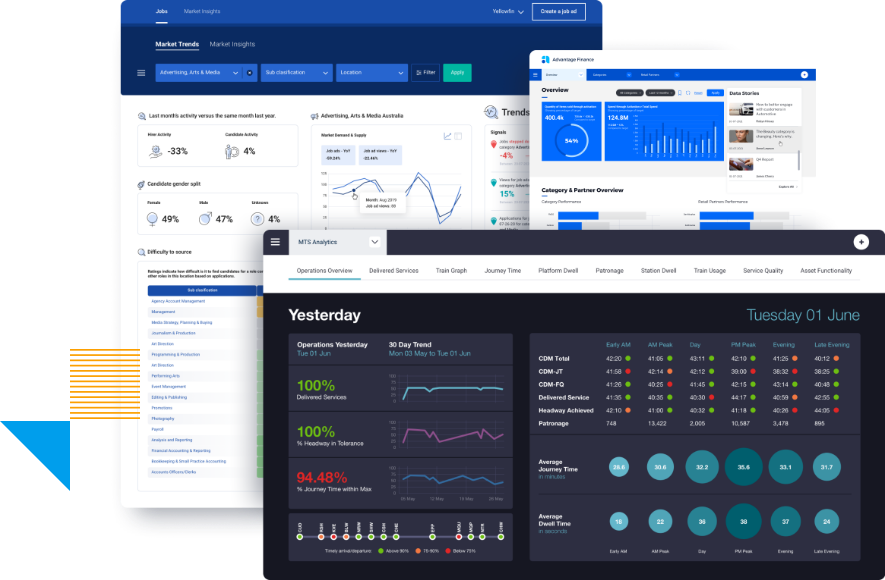Whether you’re an independent software vendor (ISV) or enterprise-sized company, you want the analytics software you invested in to enhance your users’ decision-making, open up greater access to key data, and improve operational performance for the long-term.
However, continuously achieving these business outcomes requires a modern solution.
Many organizations still rely on older business intelligence (BI) tools for reporting due to long-term licensing. Now classed as legacy BI, these data tools range from developer-centric tooling such as SQL Server and Jasper, to platforms like Business Objects.
The challenge of legacy BI is they are often cumbersome to use, with outdated user experiences (UX) and reporting modules compared to today’s apps, resulting in frustration and delayed decision-making for your users, who turn to IT for data needs. But in today's fast-paced market, having users rely on IT to generate reports is not viable.
Our team frequently help customers move away from outdated proprietary BI systems toward modern embedded analytics tools with Yellowfin, leveraging its flexibility to:
- Bring a modern analytics experience directly into your users’ workflows
- Empower your users to independently analyze data and act on insights
- Reduce the burden on your IT department
What is legacy BI?
Legacy BI is a term used to refer to traditional, outdated, and/or often proprietary reporting systems that organizations still rely on for their data analysis needs. These systems, built on old technology stacks, were once the backbone of enterprise or everyday analytics. However, they are now cumbersome and inflexible, struggling to keep pace with modern business demands. Legacy BI platforms typically involve complex, static reporting processes that require significant IT intervention. Many rely on pre-defined queries and batch processing, making them slow and less responsive to the dynamic needs of today's requirements. Additionally, these systems often lack integration capabilities with modern data sources and cloud services, creating unnecessary data silos, and limiting the holistic view of your operations or performance overall. Finally, several legacy BI tools only provide outdated or simplistic versions of dashboards and reports that lack the interactivity (data visualization, automation, drill downs, etc) that many businesses have become accustomed to seeing from more modern analytics solutions today.
Why is application modernization for legacy BI important?
A significant number of businesses today have recognized the need to update their solutions, with several recent studies and reports showcasing a growing number of enterprises and smaller businesses looking to make a change for the benefit of their end-users’ data capability. In the 2023 Gartner CIO and Technology Executive Survey, 46% of the organizations surveyed indicated they will increase spend on application modernization and 43% will decrease investments in legacy applications and infrastructure, which includes their legacy BI tooling. In the 2023 IDG Survey, 87% of respondents cited modernization of their critical applications as a key success driver, with competitive differentiation as the number one reason for their decision to modernize their applications, including legacy BI modules. In Idera’s 2024 Modernization Survey, 80% of legacy applications have outdated reporting and analytics modules. Modernization initiatives are thus essential to overcome the limitations of legacy BI systems, stay ahead of the competition who are lagging behind with outdated platforms, and avoid some of the long-term issues that they burden organizations with, which we’ll cover in detail next.What are the limitations of legacy BI modules today?
While every company’s implementation of legacy BI differs depending on budget, sector and use case, these are the most common pain-points, based on our discussions with customers who chose to modernize their applications and BI capability with Yellowfin embedded analytics:- Limited agility: Legacy BI systems are not designed for the rapid data exploration and ad-hoc reporting processes that modern businesses expect, and require.
- High maintenance costs: Maintaining and upgrading legacy systems is costly and resource-intensive, as over time less people are able to use it or integrate newer tools and processes with it, and more expert resources are required for further up-keep.
- Data silos: Integration with new data sources is challenging, resulting in fragmented data landscapes, often limiting the ability to report or analyze data to smaller teams or IT.
- User dependency on IT: Your business users end up relying on your IT department or data experts for report generation and data analysis, leading to delays in decision-making and insight sharing, and potentially reduced productivity as they fail to leverage the tool altogether.
- Lack of real-time insights: Legacy systems often cannot provide real-time data analytics, which is crucial for timely decision-making today.

How does embedded analytics modernize legacy BI systems?
Simply put, embedded analytics solutions drive the modernization of your legacy BI systems by directly integrating advanced analytics capabilities into your users' everyday workflows, while streamlining the process of accessing, analyzing and acting on data with a guided experience. This seamless integration addresses the critical issues inherent in traditional BI platforms - that being that non-technical users often don’t leverage your legacy BI due to its complexity and it typically being separately accessed too - while providing numerous unique advantages. Using Yellowfin’s embedded analytics suite as an example, some advantages include:- Enhanced agility and user empowerment: Yellowfin's embedded analytics enable users to access and analyze data without leaving their primary applications. This eliminates the dependency on IT departments for report generation, and allows your non-technical users to independently explore data. The self-service BI features of Yellowfin’s Guided Natural Language Query (NLQ) feature, for example, empower your users to ask questions of their data-sets in plain non-technical language and receive instant, actionable insights, drastically improving decision-making speed and agility.
- Cost efficiency and maintenance: By integrating Yellowfin’s embedded analytics, you can reduce the costs associated with maintaining separate, outdated BI systems. Its flexible deployment options mean that Yellowfin can be scaled as needed, ensuring your solution grows with your business without incurring significant additional costs. ISVs can also use the new analytics module as a value add-on to increase prices for customers.
- Elimination of data silos: Yellowfin’s embedded analytics integrate seamlessly with a wide range of data sources, providing your business with a unified view of all its data. This integration ensures your users have access to comprehensive, consolidated insights, without the need for disparate systems. By breaking down data silos, Yellowfin enhances data accessibility and collaboration across your organization, leading to more informed and cohesive decision-making processes.
- Automation and real-time insights: Yellowfin's automation features, including Signals and Assisted Insights, proactively identify and deliver relevant data changes and trends. Signals automatically detect critical changes in your data, notifying users of anomalies or opportunities as they happen. Assisted Insights automatically analyzes data and provides in-depth explanations and visualizations, helping your users to understand the "why" behind data changes. These features ensure that everyone has real-time, data-driven insights at their fingertips, enhancing their ability to respond quickly to market dynamics.
- Seamless integration and data security: Yellowfin supports multi-tenancy and Single Sign-On (SSO), which ensure flexible architecture and deployment options. Multitenancy allows multiple users or clients to operate within a single instance of the software while keeping their data secure and isolated. SSO simplifies the user experience by enabling secure, unified access across various applications and data sources, enhancing both security and usability. Finally, role-based access controls (RBAC) allow you to set permissions and ensure the right groups of users have access to the data they need.
